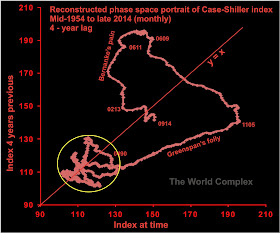IKN asks (well, not really), and the World Complex delivers.
Is the current gold-copper ratio unusually high? Based on the month-end closing price, the ratio stands at about 504.
The ratio has only very briefly touched such highs in the last ten years--most notably (and briefly) the last time the world broke.
In fact, over the last 25 years or so, the ratio has pretty much always been below 500. We only see little pop-ups that last no more than a couple of months. This has created a normalcy bias in many observers' minds.
If we go back a few years more, we see this:
In the mid-1980s, the gold-copper ratio spent years higher than 500. And there are at least three areas of stability in this range.
So what happened? Were either gold or copper fundamentally different from today? Did they gain some neutrons or protons or quarks or something in the last quarter century?
As I recall, in the early '80s we had an economic slowdown in much of the developed parts of the world, and the China-growth story hadn't yet got going. The relatively lower gold-copper ratio of the last 25 years may be due to the great build in China. If the rate of building here (China) is going to be a little lower going forward (and people here are worried about falling real estate prices as it is), then it is perfectly reasonable for the gold-copper ratio to not only remain where it is, but possibly surge to levels we haven't seen for 30 years.
Even if China's economy doesn't fall off a cliff, it may have reached the point where the rate of building slows. And while there are other places in the world that need building (Africa and Indonesia really come to mind here), there isn't a lot of money willing to go there just yet.
Is the current gold-copper ratio unusually high? Based on the month-end closing price, the ratio stands at about 504.
The ratio has only very briefly touched such highs in the last ten years--most notably (and briefly) the last time the world broke.
In fact, over the last 25 years or so, the ratio has pretty much always been below 500. We only see little pop-ups that last no more than a couple of months. This has created a normalcy bias in many observers' minds.
If we go back a few years more, we see this:
In the mid-1980s, the gold-copper ratio spent years higher than 500. And there are at least three areas of stability in this range.
So what happened? Were either gold or copper fundamentally different from today? Did they gain some neutrons or protons or quarks or something in the last quarter century?
As I recall, in the early '80s we had an economic slowdown in much of the developed parts of the world, and the China-growth story hadn't yet got going. The relatively lower gold-copper ratio of the last 25 years may be due to the great build in China. If the rate of building here (China) is going to be a little lower going forward (and people here are worried about falling real estate prices as it is), then it is perfectly reasonable for the gold-copper ratio to not only remain where it is, but possibly surge to levels we haven't seen for 30 years.
Even if China's economy doesn't fall off a cliff, it may have reached the point where the rate of building slows. And while there are other places in the world that need building (Africa and Indonesia really come to mind here), there isn't a lot of money willing to go there just yet.






































